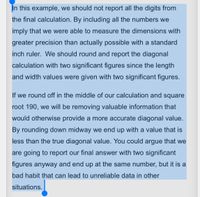
Calculus: Early Transcendentals
8th Edition
ISBN: 9781285741550
Author: James Stewart
Publisher: Cengage Learning
expand_more
expand_more
format_list_bulleted
Question
Agree or not agree and why

Transcribed Image Text:In this example, we should not report all the digits from
the final calculation. By including all the numbers we
imply that we were able to measure the dimensions with
greater precision than actually possible with a standard
inch ruler. We should round and report the diagonal
calculation with two significant figures since the length
and width values were given with two significant figures.
If we round off in the middle of our calculation and square
root 190, we will be removing valuable information that
would otherwise provide a more accurate diagonal value.
By rounding down midway we end up with a value that is
less than the true diagonal value. You could argue that we
are going to report our final answer with two significant
figures anyway and end up at the same number, but it is a
bad habit that can lead to unreliable data in other
situations.
Expert Solution
arrow_forward
Step 1
It is more accurate to the rounded calculation lastly and not in the middle.
Step by stepSolved in 2 steps

Knowledge Booster
Learn more about
Need a deep-dive on the concept behind this application? Look no further. Learn more about this topic, calculus and related others by exploring similar questions and additional content below.Similar questions
- (discrete math) 1. Recall that knights always tell the truth and knaves always lie. You encounter two people, A and B. Determine, if possible, what type both A and B are: A says “The two of us are both knights” and B says “A is a knave.”arrow_forwardPls help ASAParrow_forwardDetermine whether the statement below is true or false. If ACB and dEB, then DEA Choose the correct answer below. O A. The statement is false. The correct statement is If ACB and dEA, then dEB. B. The statement is true.arrow_forward
- Need this answer.Thank youarrow_forwardAnswer 2 and 3 in the question. Please make sure the answers are correct. This question is in three parts. Given the premises: If the steak is well done, it’s overcooked. If the steak is overcooked, the fire alarm will go off. Either the batteries have been changed or the fire alarm will not go off. The batteries have only been changed if the ladder is in the room. The ladder is not in the room. Conclude that the steak is not well done. 2. These premises don’t make sense in the real world. Why? 3. How can you change the premises so that they make sense in the real world?arrow_forwardhelp please answer in text form with proper workings and explanation for each and every part and steps with concept and introduction no AI no copy paste remember answer must be in proper format with all workingarrow_forward
arrow_back_ios
arrow_forward_ios
Recommended textbooks for you
 Calculus: Early TranscendentalsCalculusISBN:9781285741550Author:James StewartPublisher:Cengage Learning
Calculus: Early TranscendentalsCalculusISBN:9781285741550Author:James StewartPublisher:Cengage Learning Thomas' Calculus (14th Edition)CalculusISBN:9780134438986Author:Joel R. Hass, Christopher E. Heil, Maurice D. WeirPublisher:PEARSON
Thomas' Calculus (14th Edition)CalculusISBN:9780134438986Author:Joel R. Hass, Christopher E. Heil, Maurice D. WeirPublisher:PEARSON Calculus: Early Transcendentals (3rd Edition)CalculusISBN:9780134763644Author:William L. Briggs, Lyle Cochran, Bernard Gillett, Eric SchulzPublisher:PEARSON
Calculus: Early Transcendentals (3rd Edition)CalculusISBN:9780134763644Author:William L. Briggs, Lyle Cochran, Bernard Gillett, Eric SchulzPublisher:PEARSON Calculus: Early TranscendentalsCalculusISBN:9781319050740Author:Jon Rogawski, Colin Adams, Robert FranzosaPublisher:W. H. Freeman
Calculus: Early TranscendentalsCalculusISBN:9781319050740Author:Jon Rogawski, Colin Adams, Robert FranzosaPublisher:W. H. Freeman
 Calculus: Early Transcendental FunctionsCalculusISBN:9781337552516Author:Ron Larson, Bruce H. EdwardsPublisher:Cengage Learning
Calculus: Early Transcendental FunctionsCalculusISBN:9781337552516Author:Ron Larson, Bruce H. EdwardsPublisher:Cengage Learning

Calculus: Early Transcendentals
Calculus
ISBN:9781285741550
Author:James Stewart
Publisher:Cengage Learning

Thomas' Calculus (14th Edition)
Calculus
ISBN:9780134438986
Author:Joel R. Hass, Christopher E. Heil, Maurice D. Weir
Publisher:PEARSON

Calculus: Early Transcendentals (3rd Edition)
Calculus
ISBN:9780134763644
Author:William L. Briggs, Lyle Cochran, Bernard Gillett, Eric Schulz
Publisher:PEARSON

Calculus: Early Transcendentals
Calculus
ISBN:9781319050740
Author:Jon Rogawski, Colin Adams, Robert Franzosa
Publisher:W. H. Freeman


Calculus: Early Transcendental Functions
Calculus
ISBN:9781337552516
Author:Ron Larson, Bruce H. Edwards
Publisher:Cengage Learning